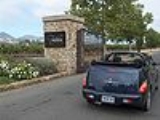
Trefethen Vineyards
Encyclopedia

National Register of Historic Places
The National Register of Historic Places is the United States government's official list of districts, sites, buildings, structures, and objects deemed worthy of preservation...
as the only 19th-century, wooden, gravity-flow winery surviving in Napa County. The winery is also known for an extensive garden established by Katie. It has been featured in many publications and has been a destination for many gardening enthusiasts since it was created.
Eugene Trefethen died in 1996 and Katie Trefethen died in 2007.
Awards
In 1979, a Wine OlympicsWine Olympics
A Wine Olympics was organized by the French food and wine magazine GaultMillau in 1979; a total of 330 wines from 33 countries were evaluated by 62 experts from ten nationalities. The 1976 Trefethen Vineyards Chardonnay from the Napa Valley won the Chardonnay tasting and was judged best in the...
was organized by the French wine and food magazine, GaultMilllau. A total of 330 wines from 33 countries were evaluated by 62 experts from ten countries. The 1976 Trefethen Vineyards Chardonnay
Chardonnay
Chardonnay is a green-skinned grape variety used to make white wine. It is originated from the Burgundy wine region of eastern France but is now grown wherever wine is produced, from England to New Zealand...
won first place in that category and was judged best in the world.
History
The original Eschol winery was commissioned by James and George Goodman and constructed in 1886 by a Scottish sea captain named Hamden McIntyre. The original estate was 280 acres with 40 acres planted in vineyards. McIntyre designed it as a gravity-flow system: a horse-drawn winch brought grapes to the third floor of the three-story structure for crushing; gravity carried the juice to the second floor for fermentingFermentation (food)
Fermentation in food processing typically is the conversion of carbohydrates to alcohols and carbon dioxide or organic acids using yeasts, bacteria, or a combination thereof, under anaerobic conditions. Fermentation in simple terms is the chemical conversion of sugars into ethanol...
; and, eventually, the wine descended to the first floor for aging. The vineyard
Vineyard
A vineyard is a plantation of grape-bearing vines, grown mainly for winemaking, but also raisins, table grapes and non-alcoholic grape juice...
s survived Prohibition in the United States
Prohibition in the United States
Prohibition in the United States was a national ban on the sale, manufacture, and transportation of alcohol, in place from 1920 to 1933. The ban was mandated by the Eighteenth Amendment to the Constitution, and the Volstead Act set down the rules for enforcing the ban, as well as defining which...
by producing grapes for the production of sacramental wine
Sacramental wine
Sacramental wine, Communion wine or altar wine is wine obtained from grapes and intended for use in celebration of the Eucharist...
. However, by 1940, the vineyards and winery building fell into disuse.

